Click here to jump to the update
Additionally, this article is substantially complemented and expanded by a later article, First National Archives, which contains photographs from its own history. A 3rd article, 1st National, 75 Years Later, is here.
In this post, unless otherwise noted, click on images in this post for larger views.
Standing Alone
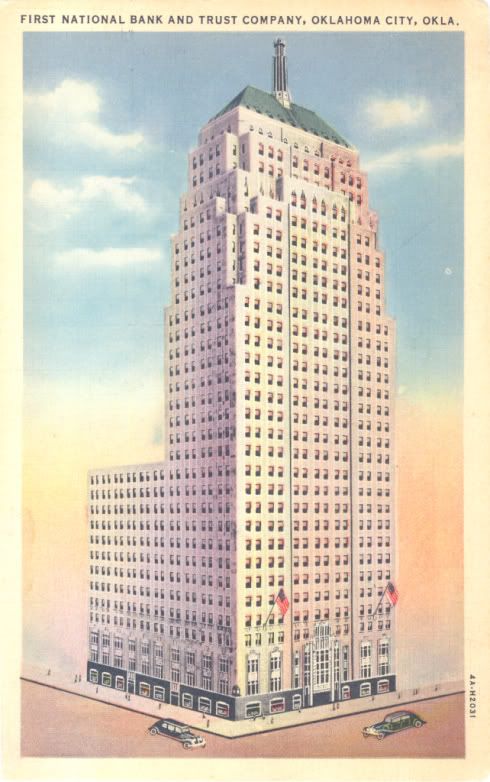
Next To Ramsey Tower

And Showing The Older Petroleum Building
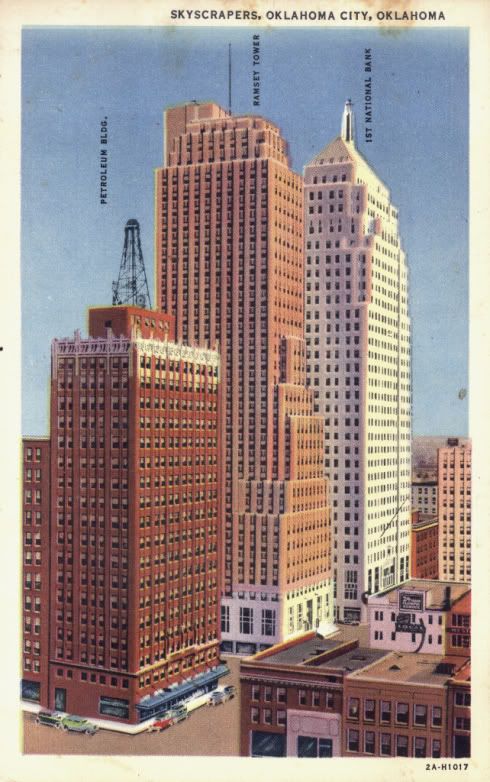
Plans for "the tallest building in Oklahoma" were splashed across The Oklahoman's front page on April 20, 1930 ...
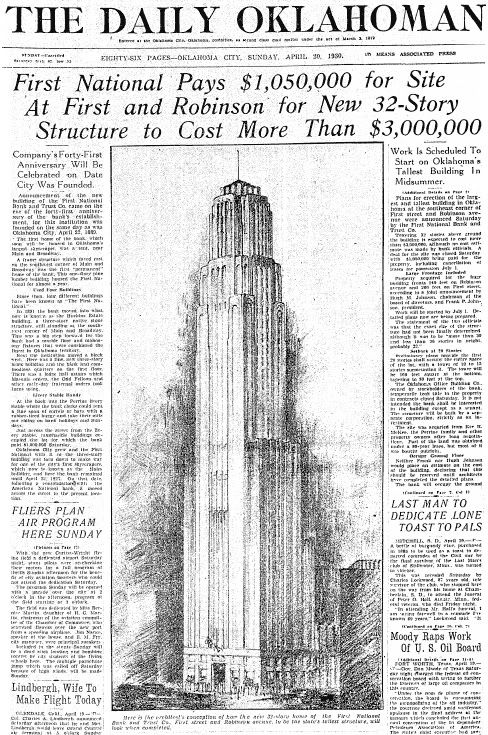
Actually, other "significant" buildings were then or shortly thereafter contemplated to be built, making "1931" one of the most dazzling years of downtown's construction history ... it was a "heady" time ... the Skirvin Tower, the YWCA (on Park Avenue, then 1st Street), the Ramsey Tower (City Place, today), the Biltmore Hotel, as well as the 1st National, had target completion dates in the year 1931, as was shown in this January 4, 1931, Oklahoman article ...

The Great Race
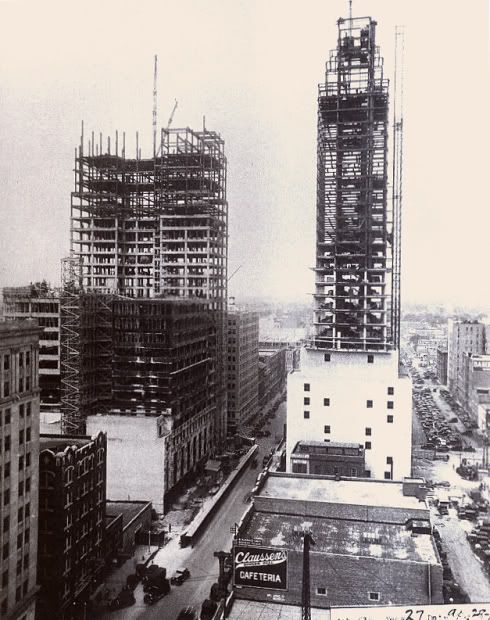
The Ramsey Tower (now City Place) won the race by a hair on October 3, 1931. Even though both buildings have the same number of stories (32), most observers would come to identify the First National as the city's "signature" downtown skyline building, perhaps because of its similarity to New York's Empire State Building, perhaps because it edged out Ramsey in overall height (not stories) by reason of its prominent "beacon," or, perhaps, it was just a little fancier! Have a look at the very fine art deco swans, peacocks, and ivy, on the entry's facade ...
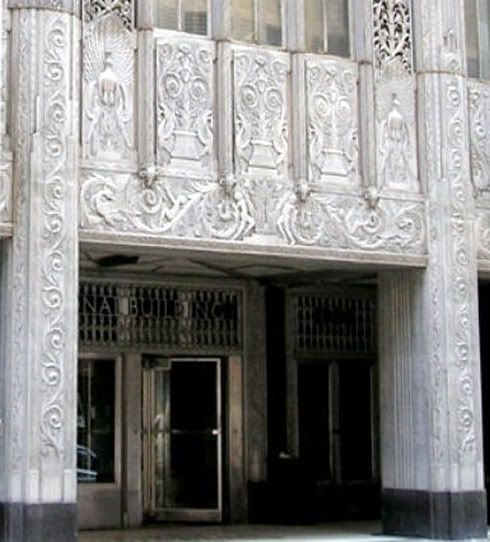
Credit: Terry L. Griffith's Oklahoma City – 1930 to the Millennium (Arcadia Publishing 2000)
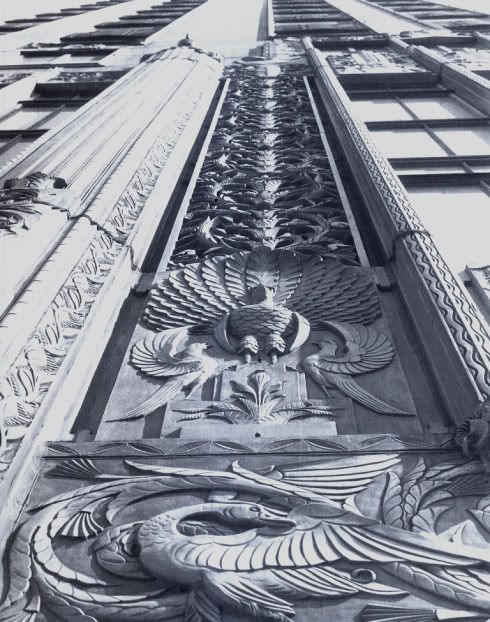
The Beacon. The "beacon" at the top wasn't a "radio transmission tower," as I'd earlier thought. Instead, it was an "aviation" beacon, which, according to a November 29, 1930, Oklahoman article, would be "visible for 50 miles." The article said,
Present plans call for a revolving beacon visible 50 miles, the distance between Oklahoma City and Chickasha. A stationary beacon, constantly pointing toward the municipal airport, will be a part of the equipment. This beacon will be so strong it will cast shadows at the airport, eight miles from the bank.The "antenna" shown atop the beacon, below, was not in the original building.
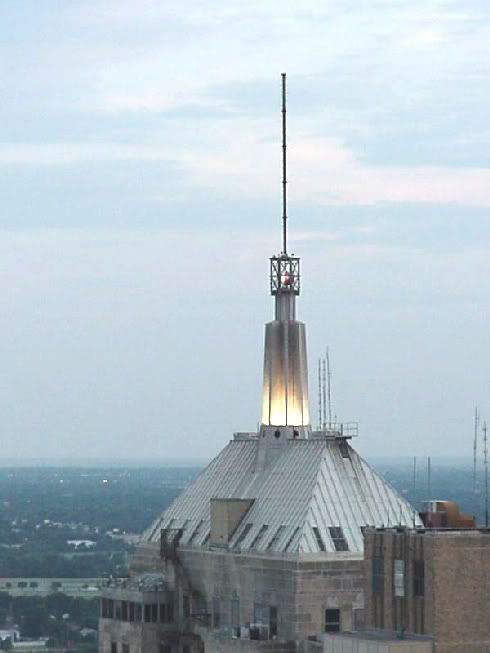
Skipping a decade but along the same vein, Oklahoma City's excellent "Beacon Club" located itself in the top of the 1st National in 1941, below the "beacon." According to the Beacon Club's history page ...
The Club opened in the late 1941 on the 31st floor of the First National Building. All equipment and furnishings were owned and operated by Faber "Goob" Reid and he called his operation the "Rainbow Room."The club would eventually come to occupy the top 3 stories of the 1st National. But, with the building's decline and it having no apparent prospects for revitalization, the club moved to the Oklahoma Tower in 1997.
The Big Bust. Fueled by the domino effect of July 1982's Penn Square Bank closing and the "Oil Bust" itself, the 1st National Bank, once the state's largest bank with assets reported to be $3.3 billion in 1982, collapsed, as well. The Oklahoman's headlines on July 15, 1986, told the tale:
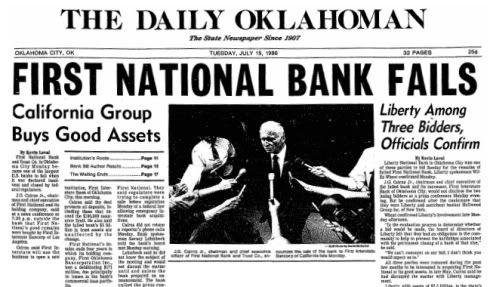
By this time, huge losses ($66 million in 1985, $45 million in 1st quarter 1986) had occurred and assets had shrunk to $1.8 billion from 1982's $3.3 billion. 1st Interstate Bank of California acquired the assets and, for time, it operated in the existing premises. That bank was acquired by Boatsmen's Bank in 1991 and in 1992 Boatsmen's decided that 1993 would be the time to move on, to Leadership Square. According to a May 29, 1992, Oklahoman article,
Boatsmen's and its predecessors have served as anchor tenant in the 1 million share-foot First National Building since its construction at 120 N Robinson in 1931. Loss of the bank, which occupies about 25 percent of the 32-story skyscraper, casts uncertainty over the future of what many consider an architectural masterpiece, observers say.But, even after the 1993 Boatsmen's move, by hook or crook the building has remained open, even though its Great Banking Hall has remained empty.
"It's the demise of that building ... you can forget it," said Ed Townsend, president of Local Federal Bank, the First National Building's largest creditor. "This thing is dead. There's no way the building can survive without the bank there. Boatsmen's decision to vacate will force a total closing of the facility. This demonstrates total lack of sensitivity for the historical importance of this building and shows no concern over what this would do to downtown Oklahoma City. I think they're making a terrible mistake," Townsend said.
* * *
The drama began unfolding in the late 1980s, when officials with First Interstate Banks of Oklahoma – purchased by Boatmen's in 1991 – essentially issued an ultimatum to building owner First Oklahoma Corp. To either rehabilitate the aging tower, or lose the bank as a tenant. Estimates of the needed repairs and upgrading ran as high as $20 million.
But the building also has about 36 creditors and mortgage holders. Because of the unusually large number of parties involved, no consensus on its rehabilitation has ever been reached, according to those involved in negotiations.
* * *
The bank's departure will send the historic First National Building's occupancy from 72 percent to about 54 percent, according to the Price Edwards data.
"I think it's a major blow to one of the real landmarks in downtown Oklahoma City," said local historian and author Bob Blackburn.
Skipping over legal stuff, changes in ownership, etc., some apparent good news occurred in May 2006 with a California group’s purchase of the First National Center which includes more than one million square feet of leasable space. As reported in The Oklahoman and as discussed at OkcTalk.com and at OkMetropolis.com, according to the agent that handled the transaction, the new owners have great intentions:
"Plans are to bring it back to its former glory as the crown jewel of downtown Oklahoma City. To fill it up – and dress her up and take her to the ball. Have a centennial ball in the Grand Banking Hall."
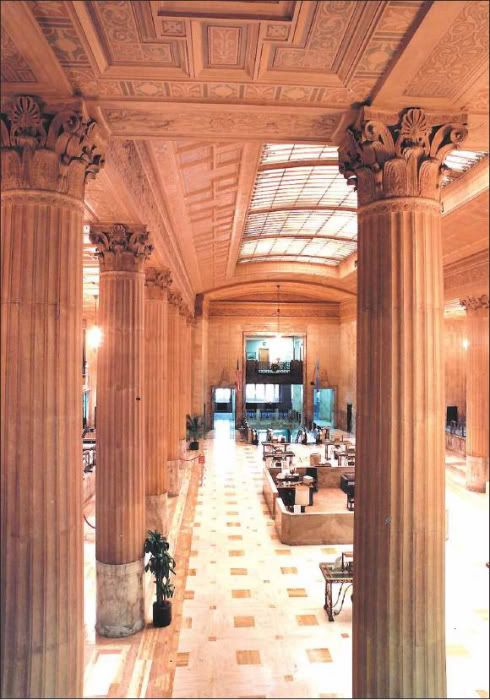
See this OkcTalk.com thread and this one and this one at OkMetropolis.com for much more about that.
During the year since the 2006 sale, "innards" have been worked on but nothing splashy has been done yet, nor have any overall plans been announced by the California owners. A few press articles keep the hope alive, though, that the First National will rise again like the other Phoenixes that downtown seems to be enjoying in this time that we live.
An April 16, 2007, Journal Record article discussed possible plans for making the basement "vault" areas into a glorious restaurant. A September 20, 2006, Oklahoman article by Steve Lackmeyer said, in part,
The new owners of the First National Center pledged Tuesday they are prepared to spend at least $6 million on renovations and are considering converting some floors into housing.So, yes, generalities have been stated but no "visionary" type of plan has yet emerged. A March 23, 2007, Lackmeyer article notes that the new owners had spent about $1 million on renovations so far, largely on infrastructure, except that they had gotten the historic "clock" on the corner of Park and Robinson , dead for a decade, to work again as at least some indicia of visible improvement.
Owners of Los Angeles-based Milbank Real Estate shared their plans Tuesday morning with about 50 civic and business leaders gathered at the Oklahoma City Golf and Country Club.
Chief Executive Officer Aaron Yashouafar and Raymond Yashouafar, vice president of operations, reiterated promises to return the building to its glory days – including a concierge service that was eliminated several years ago.
The Yashouafars say they've discovered the costs of bringing the complex back to Class A office space are higher than the $6 million they cited in September. But they remain committed to the overhaul, and will soon unveil a master plan drawn up by Beck and Associates.We hope, and we wait, for the promise to be fulfilled!
March 25, 2008 Update. Since the above post was written almost a year ago (5/11/2007), the opportunity for the Grand Banking Hall to host a Centennial Ball came and went without one ... the clock on the corner of Robinson & Park Avenue got fixed ... and, according to the owners, a good bit of infrastructure work got done, e.g., sprinkler system updates, etc., at a cost of $1.2 million. For those who noticed, a working "clock" was the only thing publicly visible.
Otherwise, the 1st tangible sign of "new life" came with 1st National hosting the December 11, 2007 watch party for the huge bond proposal that passed with flying colors on that day. In its press release, the owners stated,
OKLAHOMA CITY (Dec. 11, 2007) – Milbank Real Estate, the Property Management Company for First National Center, is hosting the city’s bond election watch party as its first major civic event, bringing back the grandeur of Oklahoma City’s grandest historic building as a statement of their commitment to fully restoring First National Center’s majestic Art Deco architecture and décor.
"Together, tonight marks another historic milestone for Oklahoma City and First National Center," said Raymond Yashouafar, vice president of operations for Milbank Real Estate. "As the voters decide on the city’s largest bond issue, we are working to keep the momentum going by renovating Oklahoma City’s most prestigious building to its original stature for business. It will be exciting to see the Great Banking Hall come alive again."
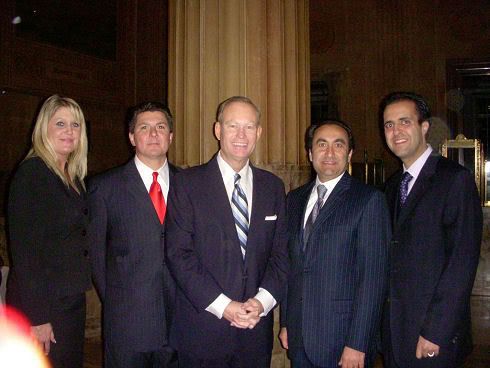
On March 13, 2008, Phase 1 was announced by the owners ... and with something a bit more splashy ... but at $1.5 million, one would be foolish to expect too much. Overhaul of the building's retail arcade and a new Park Avenue entrance were announced.
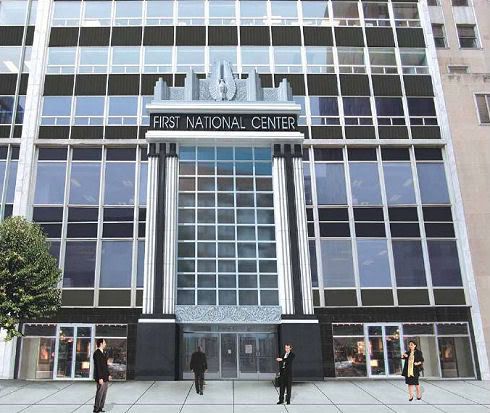
The Existing Park Avenue Entrance (by the Hallmark Shop)
(West addition [right] was built in 1957, the East in 1972)

Superimposing the New Entrance Gives This Picture

While nice enough, it doesn't exactly knock Doug Dawgz socks off as amounting to a "major" development.
What about on the inside? Some drawings from the owners' website appear below (larger images are not available):
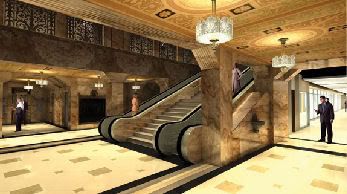

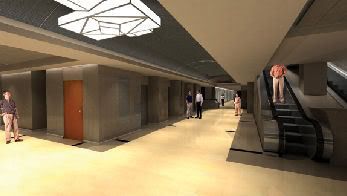
Lt. Gov. Jari Askins was there for the announcement with a symbolic jackhammer showing signs of getting ready to tear out the marble floor in the 1st National Entry! "Woah!," said some ... getting rid of the marble floor?
According to Steve Lackmeyer's article, Aaron Yashouafar said that it was not original to the tower and the replacement flooring will be in keeping with the original construction. I have no idea what that might mean.
Concerns have been expressed, some by John Hefner, a 3rd generation tenant ... see Steve's March 25, 2008, article, Clock ticking on strategy for First National Tower.
Hefner and several other tenants I've spoken to worry whether the floor's destruction is evidence that the owners have no regard for the tower's history. They previously were upset when an attempt to increase rent on the tower's original barbershop ended with the tenants moving their booths elsewhere. A year later, the barbershop — still adorned with black and white Art Deco tile and fixtures — stands dark and empty.
Courtesy Norman Thompson
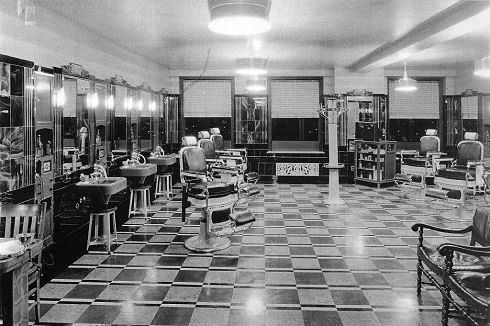
Hefner was more particular in a letter he wrote to Steve Lackmeyer which is set out in Steve's OKC Central blog today. There, among other things, Mr. Hefner said,
At 55, I do not consider myself to be so old that I live in the past, yet I do have appreciation for great things that were created before I was born, and certainly that is the case with historic buildings. When the First National Bank Building was constructed in 1931 at great expense, it was truly an “A” class building, and both the exterior and interior features revealed it. Since it was so high-end, and not average, people wanted to lease space in it. * * * My childhood was filled with endless trips through the building, and year after year, I loved seeing a huge, decorated tree in the Great Banking Hall at Christmas. * * * Overall, it was great fun working downtown.
What changed? The crash of that oil boom carried the First National Bank with it. * * * Several owners since then have failed to have the vision to see that this architectural gem was built to be an “A” class building. Sadly, more “minimalist maintenance” came with the passage of time. As the structures on other corners have achieved lower vacancy rates, the First National has not. Over the years, landlords of the First National have let The Beacon Club, the Post Office, a travel agency, and other amenities slip away from their spaces. Key law firms and oil companies have left too. The current owners lost the barber shop; today, I know of two other tenant-service enterprises planning to leave.
The current owners, as far as I am concerned, have been big on promises, but minimal on spending what is needed. I feel that they, too, do not see the Class “A” fundamentals of the building. A couple of times, I have tried to convince these Los Angeles-based owners to spend money for quality renovations, yet I failed. I have asked for the once-operational elevator security system to be repaired, but it has not. * * *
| Sooo ... guess we'll need to wait some more to party in the Great Banking Hall ... we shall see. |  |














6 comments:
Milbank Real Estate has planned a party to be held March 12th to unveil plans for teh first phase of the renovations. Articles in the Journal of Record and Oklahoman have more details
I would be interested in this building being preserved and I love the idea of having some floors turned into residential living. Keep the landmarks alive
Remember KFNB, all music, all the time. You could go to sleep in it, pipe it into an elevator, or hook it up to a hold input on your phone system.
By the way, If I rent space, can I put a HAM repeater up there for real cheap?
N3MAL
Update Christmas 2012. They had a 20 foot tall Christmas tree in the lobby this year. It was great to see it there once again.
I have a photo of the old Liberty scroll name atop the Liberty tower with the weather beacon on top. I will attempt to post it.
Here is also a link to a tower in Pittsburgh "reestablishing" their weather beacon...
Wouldn't' it be grand and a statement for someone to once again put a weather beacon on top of the old Liberty tower! It would fit nicely with our downtown renaissance and and the WEATHER CAPITAL as well as OIL ENERGY CAPITAL of the world!
http://pittsburgh.cbslocal.com/2012/07/02/weather-beacon-to-return-atop-gulf-tower/
Post a Comment